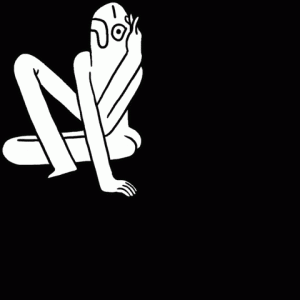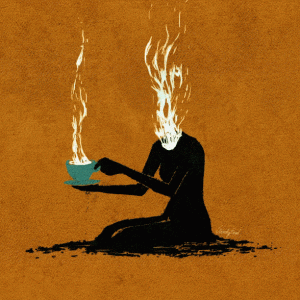The fear always starts out small, like a nagging feeling in the back of the mind that something is horribly wrong. Most of the time, you don’t notice it. The buildup is slow, but once the weight of it becomes perceptible, it’s an avalanche. Everything comes crashing down at once: your heart pounds against your ribs; your lungs fill up with dread, and you suddenly realize that you can’t breathe; waves of extreme nausea hit you over and over again. You’re shaking.
When I got my first panic attack, I was six. All I remember is hyperventilating in a bathtub while my mom tried to calm me down. Since that incident, panic attacks have been a constant in my life. The biggest struggle of having panic disorder (besides the physical panic, of course), is the fear of getting an attack.
My relationship with my panic attacks has been rough; for most of my life, I was filled with an intense hatred for them, wishing that they would just go away and never come back. About a year ago, I first started seeing a therapist about the issue, hoping she would give me a solution that would make the attacks disappear. Soon after, I got disappointing news: there was no magic cure.
I would be lying if I said that accepting my panic disorder as a part of me was easy. It was very difficult to detach from the idea that I could someday live without fear; instead, I was forced to learn how to cope with it. I was so used to running away from panic attacks, scared of the physical and emotional toll they took on me, that I didn’t even think it was possible to take control of them.
One of the most important things I heard from my therapist was a Buddhist parable about two arrows shot through your heart. The first arrow is the initial feeling of hurt; fear, anger, betrayal – the list goes on. The second arrow is the one you shoot yourself when you beat yourself up and spiral deeper into the negativity. The difference between the two arrows is that while the first one is out of our control, the second one is much easier to manage. When you choose to confront intense fear in a way that’s logical and compassionate to yourself, you are taking back control.
While changing my entire mindset about my panic attacks seemed daunting, I decided to start with the way I talked to myself about my fear. Before, my “strategy” was to attempt to suppress it or to convince myself that there was nothing to be afraid of; this kind of thinking did nothing but make me feel weak in the face of panic. I started to think of ways to display compassion for myself during panic attacks, and soon after, had a “panic algorithm” that I would follow whenever I found myself drowning in fear.
The system described below has helped me manage or avoid many panic attacks over the past few years, and I can only hope it can help someone else, too.
Step #1: Accept that it’s happening

Acknowledge the fear is the first step in my algorithm. It is present, you are experiencing it, and this is what reality looks like at the moment. At this time, I list all of the symptoms of fear I am experiencing and the thoughts that are going through my mind. Here’s an example of what my mental list would look like:
Physical experiences:
- nausea;
- fast heart rate;
- cold sweat;
- sensation of choking.
Accompanying thoughts:
- “I’m having a heart attack”;
- “I have food poisoning”;
- “I am going to faint”;
- “I am going to die.”
Once I have the list of symptoms, it is easier to examine them in the context of a panic attack, rather than giving in to the thoughts that the fear brings.
Step #2: Do a scan of the possible triggers
 Knowing the cause of the fear helps make it more of a tangible concept in my mind. Sometimes, the cause is easy to pinpoint, but whenever I find myself experiencing seemingly random anxiety, I ask myself the following questions:
Knowing the cause of the fear helps make it more of a tangible concept in my mind. Sometimes, the cause is easy to pinpoint, but whenever I find myself experiencing seemingly random anxiety, I ask myself the following questions:
- Has an emotionally draining event happened recently? After something like a fight with a friend, I tend to be very anxious for at least a few days.
- When was the last time I ate? If it was more than 3 hours ago, then there’s a high chance that I’m mistaking hunger and lightheadedness for fear.
- How much sleep did I get? Whenever I am sleep deprived or overworked, I tend to be more susceptible to anxiety attacks. This is due to the body’s inability to cope with stress and is perfectly normal.
Even though there might not be an obvious reason for the panic to occur, logical thinking helps bring you out of a chaotic mindset and into an observational one.
Step #3: Separate your fear from yourself

Even though you are experiencing it, it does not define you. Let the fear play out while being mindful about its presence. What I find to be the most helpful with this is visualizing the fear as a sentient creature. Where is it located? What does it look like?
When I feel like the fear is overtaking me, I picture it as a small bird in the centre of my chest. It is not sure what is happening, but it is very loud; in a way, it is just a child. Thinking about my anxiety in a visual form makes it harmless; so I just let it go on independently of me.
In separating from the panic, you let go of the hatred you experience towards it; seeing the fear as a separate entity allows you to treat it with compassion.
Step #4: Postpone existential thoughts

It is very common to think negatively of yourself for experiencing a panic attack; I used to bombard myself with hateful, fearful thoughts such as “it’s all my fault” or “I can’t control this, so I must be an idiot.” Now, when I find myself thinking these things, I set them aside to revisit later, when I’m in a calmer state of mind.
Make sure that your only focus, for the time being, is your safety and comfort; now is not the best time to deal with intrusive thoughts.
Step #5: Don’t spiral inwards

Fear is something that makes you disassociate from reality; some of the best advice I’ve gotten on this was from my mom, who told me to —get this— do chores.
Instead of trying to distract yourself with YouTube or Instagram, connect yourself with your surroundings through menial tasks. Vacuum the rug; call or text someone you love; get up and walk around; turn off social media; wash dishes or clean something close to you; make tea; make a list of the books you have been meaning to read.
*Pro-tip: when I don’t have access to a floor to mop or a pen, I multiply numbers in my head. Seriously —try multiplying 58 by 34. It takes up most of my mental faculties.
Step #6: Focus on the body

When you’re experiencing panic, it is much easier to calm yourself down through your body rather than through your mind. Instead of trying to convince yourself that there’s nothing to be afraid of, make an effort to physically relax your body to “trick” your brain into letting go of anxiety.
- The number one thing that I have found to help with this is savasana, or the corpse pose. Lying on your back with your palms facing up can be a very relaxing position for your body. If you’re not a fan of savasana, however, you could try any pose that opens the chest. This counteracts the fear-induced desire to curl up into a ball and freeze, which actually disrupts your breathing cycle and makes your anxiety worse. Some examples of gentle chest-opening poses are cat/cow flows or cobra pose.
- Getting warmer: hot showers are a lifesaver, but when you don’t have access to one, you can focus on warming your hands and feet, as they have a lot of nerve receptors in them. Drink something hot to warm up your insides. The inverse also works; on a hot summer day, I wouldn’t jump into a steamy shower to relieve my anxiety but drink something cool and tangy.

- Flavour, in general, plays a big role in fear relief. Studies have been done on the calming properties of dark chocolate and chamomile (and those are two of my go-to options), but other strong flavours (ginger, turmeric, lemons, spicy foods) also work for me. In general, go for something with a flavour that you actually like; don’t force yourself to eat chocolate if you hate it. If you want to combine a few of the senses, try herbal tea; it soothes your brain immediately. My personal preference is a peppermint-chamomile-ginger blend – I feel like an herbalist when I drink it.
Finally, the key thing to remember about panic is the fact that it is impossible to get stuck in it. No matter how terrible the fear feels at the moment, it will pass. When I find myself freaking out, I remind myself of the temporary nature of this feeling. And since the fear will pass, I might as well be kind to myself about it.

Illustration by Anastasia Zaristovskaya (author)
Edited by Ely Bakouche
Enjoyed reading this article? Consider supporting us on Patreon or making a one-time donation. As little as $2 will allow us to publish many more amazing articles about yoga and mindfulness.





